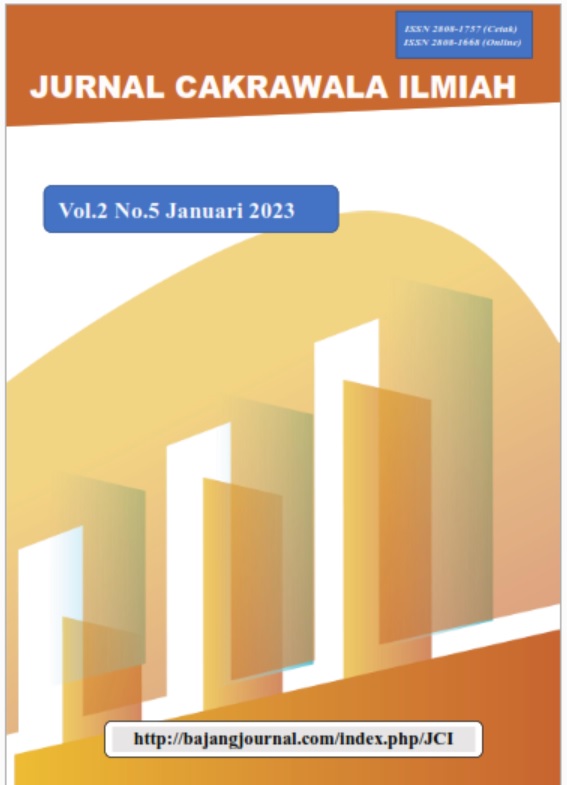GAYA KEPEMIMPINAN KEPALA SEKOLAH DI MUARA BUNGO
DOI:
https://doi.org/10.53625/jcijurnalcakrawalailmiah.v2i5.4623Keywords:
Principal, Transformational leadership styleAbstract
This research is a descriptive qualitative research. The subjects in this study were school principals, teachers and students of class V and students of class VI in 2021. The data collection techniques used in this study were observation, interviews and documentation. Data were analyzed using data reduction, data presentation and conclusion. The technique of checking the validity of the data is by using source triangulation and technical triangulation. The results showed that the leadership style used by the principal at SDN 98/II Muara Bungo, Pasar Muara Bungo District, Bungo Regency tended to be a Transformational leadership style, in which decisions were always made in meetings, discussions and deliberations with staff and teachers. The principal always accepts opinions, criticisms and suggestions from subordinates well, gracefully and sincerely and actively participates in every activity in the school. The principal always develops and prioritizes a sense of unity and oneness such as togetherness and cohesiveness.
References
Abbas, E. W. (2014). Pendidikan Karakter. Wahana Jaya Abadi.
Apdoludin. (2021). Pengantar Pendidikan. CV. Intishar Publishing. https://drive.google.com/file/d/1u8NCwopqGApsNURdEyH93hpOY_m1Jd_9/view
Baharudin dan Umiarso. 2012. Kepemimpinan Pendidikan Islam Teori dan Praktik. (Yogyakarta: Arruzz Media).,
Bush Tony, 2008. Leadership and Management Development. London: Sage. Publication Company.,
Chen, C., Tsai S., Chen, H., & Wu, H. (2016) .The Relationship between the Principal’s Positive Leadership and School Effectiveness-Take School Organizational Culture as The Mediator. European Journal of Psychological Research. 3 (2), 12-23. DOI: 10.1053/gast.2000.9373
Emron., dkk. 2016 Manajemen Sumber Daya Manusia. Alfabeta. Bandung
George Terry, 2009, Dasar-Dasar Manajemen, Bumi Aksara, Jakarta.
Giltinane, CL. (2013) . Leadership Style and Theories. Nurshing Standard. 27 (41), 35-39. DOI: 10.7748/ns2013.06.27.41.35.e7565
Moleong, Lexy J. 2007. Metodologi Penelitian Kualitatif. Edisi Revisi. Bandung : PT Remaja Rosdakarya.
Moorosi, P. & Bantwini, B. D. (2016). School District Leadership Styles and School Improvement: Evidence from Selected School Principals in the Eastern Cape Province. South African Journal of Education. 36(4), 1-9. https://doi.org/10.15700/saje.v36n4a1341
Ng, F.S.D., Nguyen, T. D., Wong, K.S.B., & Choy, K. W. W. (2015). Instructional leadership practices in Singapore. School Leadership & Management. 35 (4), 388-407. doi: 10.1080/13632434.2015.1010501
Northouse, Peter G. 2013. Kepemimpinan: Teori dan Praktik. Jakarta: PT. Indeks. Permata Puri Media.
Rahim Saidek, A., Islami, R., & Apdoludin. (2016). Character Issues: Reality Character Problems and Solutions through Education in Indonesia. Journal of Education and Practice, 7(17), 158–165. www.iiste.org
Ross, D. J. & Cozzens, J. A. (2016). The Principalship: Essential Core Competencies for Instructional Leadership and Its Impact on School Climate. Journal of Education and Training Studies. 4 (9), 162-176. doi:10.11114/jets.v4i9.1562
Wahjosumidjo. (2010). Kepemimpinan dan Motivasi, Jakarta: Ghalia Indonesia.
Downloads
Published
How to Cite
Issue
Section
License
Copyright (c) 2023 Jurnal Cakrawala Ilmiah

This work is licensed under a Creative Commons Attribution-NonCommercial 4.0 International License.
















